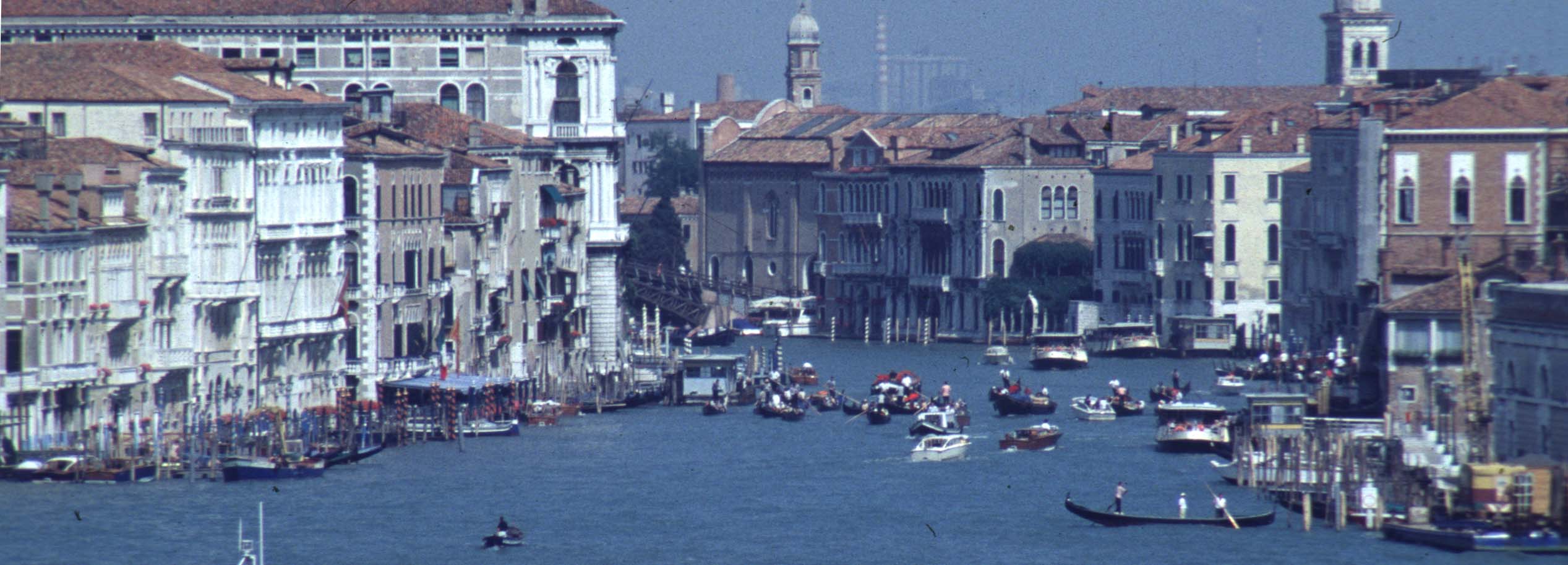
Venice, Italy

|
When the ferry finally pulled into
Venice, I was STUNNED! Venice is everything it is claimed to be.
I stood on the top deck of the ferry and just gasped. The view
of the Venice skyline was astonishing, with beautiful pastel pinks and
cremes and blues and golds. I think I took a whole roll of film in
ten minutes time.
...After a quick lunch, Alex and I hopped on a vaparetto and cruised up the Grande Canale—not in the direction that we intended but still incredibly great! The Grande Canale weaves for 2 miles through the city like  a
huge, upside-down “S”, and the parade of incredible buildings, including
more than 100 palaces dating from the 12th to the 18th century was astonishing.
It is remarkable that a place as unique as this exists! As we cruised
up the canale, gondolas, little motor boats, and police boats cruised by.
There are no cars on the islands—all public transportation is through the
canals via the vaporettos (small passenger boats) and even all police and
emergency vehicles are boats. WOW! A city with no cars—incredible
to imagine. At the end of the line, we jumped back on and rode the vaporetto
its entire route to the other end of the line. What an incredible,
incredible ride! a
huge, upside-down “S”, and the parade of incredible buildings, including
more than 100 palaces dating from the 12th to the 18th century was astonishing.
It is remarkable that a place as unique as this exists! As we cruised
up the canale, gondolas, little motor boats, and police boats cruised by.
There are no cars on the islands—all public transportation is through the
canals via the vaporettos (small passenger boats) and even all police and
emergency vehicles are boats. WOW! A city with no cars—incredible
to imagine. At the end of the line, we jumped back on and rode the vaporetto
its entire route to the other end of the line. What an incredible,
incredible ride!
The neighborhood where we disembarked, Canareggio, was were we decided it was time to find a hotel and drop off our packs. It wasn’t long before we were out exploring again though! Our first destination was the Jewish Ghetto. (It is hard to really say there are “destinations” in a place like Venice, where the route is just as amazing as the final destination.) The ghetto, called the Ghetto Nuovo, is the world’s oldest ghetto. In 1516, all Jews living in Venice were ordered to move to the small island, where they were locked in at night by Christian soldiers and forced to follow a set of rules that limited their social and economic activities, but did not suppress their religion. The low entrance to the ghetto and the heavy gate doors still remain and impart an eerie feeling. The buildings inside are unlike any I have seen. Extreme overcrowding, combined with building regulations strictly limiting the height of the buildings, meant that some apartment buildings in the area have as many as seven stories in a building that would normally have four or five. The floors are stacked so tightly that the windows for each floor are right on top of each other. It wasn’t until 1797 that Jews were allowed to leave the Ghetto to live anywhere in the city. |
|
|
We then walked around the narrow streets and across the many bridges of
Venice. It was such an incredible scene. Venice is built on
117 small islands, has some 150 canals and more than 400 bridges.
Wow! We eventually circled back to Piazza San Marco, aka Saint Mark’s
Square. This is one of the most famous and beautiful squares in the
world, and is notorious for hosting flocks of pigeons and tourists.
The Basilica di San Marco, at the end of the huge square, was built to
house the body of St. Mark, which Venetian merchants stole from Alexandria,
Egypt in 828 AD. The building has been richly embellished over centuries
by the booty of the Crusades--mosaics, precious marble, and other treasures…
Day two—Unfortunately, very few tourists stray more than a few
streets from the main square, a real shame as the secret to really discovering
the romance and beauty of Venice is to walk through the authentic, tranquil
parts of the city. There are whole sections of Cannaregio, Dorsoduro
and Castello that are virtually empty of tourists. As we walked along the
canals, I began to see the full tragedy of the slow disintegration of the
city due to constantly rising tides. The city is actually sinking:
it sank by ten inches in the first 80 years of this century. A city
with such a rich history and such an awe-inspiring landscape must be preserved!
The rich history of Venice is visible around every corner. The city
was created when the barbarian invasions of the 5th and 6th centuries forced
the people living along the Adriatic coast to flee to the marshy islands
of the Venetian lagoon. By the late 10th century, Venice had become
an important trading city and a great power in the Mediterranean. Venice
even led the fourth Crusade, acquiring both the goodies plundered from
Constantinople and most of the territories won during the crusade.
A city this incredible must have been quite an experience back then, especially
since it is quite an experience today!…
|
|